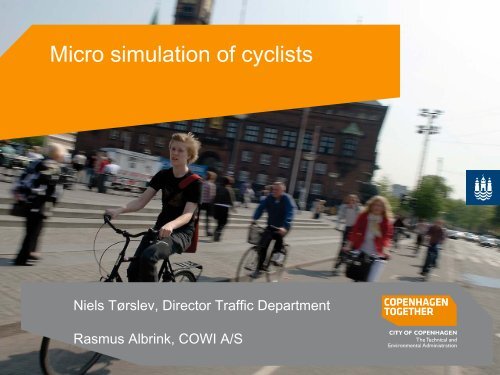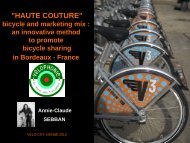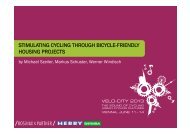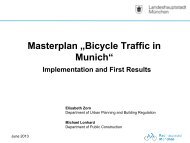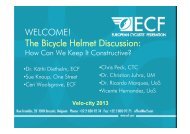Micro simulation of cyclists - Velo City
Micro simulation of cyclists - Velo City
Micro simulation of cyclists - Velo City
- No tags were found...
You also want an ePaper? Increase the reach of your titles
YUMPU automatically turns print PDFs into web optimized ePapers that Google loves.
<strong>Micro</strong> <strong>simulation</strong> <strong>of</strong> <strong>cyclists</strong>Niels Tørslev, Director Traffic DepartmentRasmus Albrink, COWI A/S
Rising amount <strong>of</strong> cyclist in Copenhagen the past 40 years2Tilføj præsentationens titel i "Indsæt/ Sidehoved og Sidefod"
It is not just for fun - we have congestion on the cycle tracks3
<strong>Micro</strong> <strong>simulation</strong> <strong>of</strong> <strong>cyclists</strong> in peak hour traffic4<strong>Micro</strong> <strong>simulation</strong> <strong>of</strong> <strong>cyclists</strong><strong>Velo</strong> <strong>City</strong> 2013
The project's background•The correct capacity•Estimated volumes•No left turn•Standard cyclistbehavior5<strong>Micro</strong> <strong>simulation</strong> <strong>of</strong> <strong>cyclists</strong><strong>Velo</strong> <strong>City</strong> 2013
General method• Setting the basic parameters• Vehicle characteristics• Speed distributions• Acceleration distributions• Modeling bike paths• Following parameters• Overtaking parameters• Behavior at narrowing sections• Behavior at bus stops• Modeling <strong>cyclists</strong> in intersections• Behavior in waiting zones• Behavior at stop lines• Behavior at right turns6<strong>Micro</strong> <strong>simulation</strong> <strong>of</strong> <strong>cyclists</strong><strong>Velo</strong> <strong>City</strong> 2013
General method•Traffic counts•Speed counts(even path, up hill, down hill, normal bikes, carrier bikes, electrical bikes)•Video material•Visual inspection•LiteratureAnalysis <strong>of</strong>video materialTest in VISSIMComparingto videoValidation in regard totraffic volumes7<strong>Micro</strong> <strong>simulation</strong> <strong>of</strong> <strong>cyclists</strong><strong>Velo</strong> <strong>City</strong> 2013
General method•More complex than initially assumed•Many different behavioral patterns along a bike path8<strong>Micro</strong> <strong>simulation</strong> <strong>of</strong> <strong>cyclists</strong><strong>Velo</strong> <strong>City</strong> 2013
Example – Following and overtakingParameter Description Expectation to the calibration•Detailed understanding <strong>of</strong> the modelCC0The distance between two vehiclesat full stop.Less, as <strong>cyclists</strong> keep closertogether than cars in a queue.•Best guess for parameter settingsCC1Time distance between twomoving vehicles.Less, as two moving <strong>cyclists</strong> keepcloser together than cars.•The starting point for the project was lookingCC2Variation in the distance betweentwo successive vehiclesLess, as <strong>cyclists</strong> are moreindependent and behave moreindividually than driversat CC0 and CC1CC3The limit for when followingparameters come into playLess, as <strong>cyclists</strong> are moreindependent and behave moreindividually than drivers•Ended up adjusting CC0-CC9CC4Controls the negative speedvariations between two successivevehiclesLess, as <strong>cyclists</strong> are less willing to(less obliged to) adjust their speedthan driversCC5Controls the positive speedvariations between two successivevehiclesLess, as <strong>cyclists</strong> are less willing to(less obliged to) adjust their speedthan driversCC6The dependence in speed <strong>of</strong>variations in distance to thepreceding vehicleLess, as <strong>cyclists</strong> are less willing to(less obliged to) adjust their speedthan driversCC7Acceleration in responce tovariations in distance to thepreceding vehicleLess, as bicycles don't accelerateas fast as carsCC8 Desired acceleration from 0 km/h Less, as bicycles don't accelerateas fast as carsCC9 Desired acceleration at 80 km/h Much smaller. A linear accelerationto 80 km/h is used in thecomputations9<strong>Micro</strong> <strong>simulation</strong> <strong>of</strong> <strong>cyclists</strong><strong>Velo</strong> <strong>City</strong> 2013
Example – Following and overtaking•The testing proces in VISSIM•Comparison <strong>of</strong> various settings•Calibration <strong>of</strong> the parameters•Visual validation•Validation in regard totraffic counts10<strong>Micro</strong> <strong>simulation</strong> <strong>of</strong> <strong>cyclists</strong><strong>Velo</strong> <strong>City</strong> 2013
Example - Kampmannsgade/Vester Farimagsgade•COWI has conducted a bike <strong>simulation</strong> <strong>of</strong> the intersection Kampmannsgade/VesterFarimagsgade in Copenhagen close to Vesterport Station.•The primary purpose was to determine the necessary capacity in a waiting zone infront <strong>of</strong> the right turning motor vehicles from Kampmannsgade.•Basis•Solution11<strong>Micro</strong> <strong>simulation</strong> <strong>of</strong> <strong>cyclists</strong><strong>Velo</strong> <strong>City</strong> 2013
Conclusion•It is possible to build realistic models for the bicycle traffic in Copenhagen (andother cities), but it requires a solid knowledge <strong>of</strong> VISSIM as a <strong>simulation</strong> tool.•The model build-up is more complex than in the case <strong>of</strong> motorized traffic as <strong>cyclists</strong>have a more individual behavior.•The project has determined some <strong>of</strong> the fundamental parameters, which hasbrought us much further.•Many intersection-specific behavioral patterns must be clarified before the<strong>simulation</strong>•Not a standard tool12<strong>Micro</strong> <strong>simulation</strong> <strong>of</strong> <strong>cyclists</strong><strong>Velo</strong> <strong>City</strong> 2013


